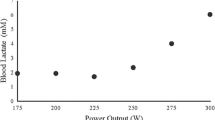Summary
The oxygen deficit and debt have conventionally been determined during exercise at constant work rates. During this study these were calculated during and after exercise at progressively incremented work rates. Five men performed two successive incremental exercise tests to exhaustion on an electronically braked cycle ergometer. The two tests were separated by a 5 min rest period. The oxygen deficit was defined as the sum of the minute differences between the measured oxygen uptake and the oxygen uptake occurring during steady state work at that same rate. The oxygen deficit was quantified for the work periods before and after the anaerobic threshold (AT) as determined from respiratory gas analysis (ATR). The measured deficit for the period before the ATR was smaller than the deficit measured in the same subjects during steady state work at low intensity (below the ATR) and was also less than the rapid component of the oxygen repayment as determined after the second incremental test. It was concluded that this test could be used for the determination of anaerobic capacity as represented by the total oxygen deficit (within motivational limits), but that the lactacid and alactacid components of the deficit could not be differentiated. A considerable portion of the alactacid component of the deficit was incurred after the onset of the ATR.
Similar content being viewed by others
References
Ahlborg G, Hagenfeldt L, Wahren J (1976) Influence of lactate infusion on glucose and FFA metabolism in man. Scand J Clin Lab Invest 36: 193–201
Astrand I, Astrand P-O, Christensen EH, Hedman R (1960) Myoglobin as an oxygen store in man. Acta Physiol Scand 48: 454–460
Astrand P-O, Rodahl K (1977) Textbook of work physiology. McGraw Hill, New York, pp 296–318
Belcastro AN, Bonen A (1975) Lactic acid removal rates during controlled and uncontrolled recovery exercise. J Appl Physiol 39: 932–936
Bergstrom J, Guarnieri G, Hultman E (1971) Carbohydrate metabolism and electrolyte changes in human muscle tissue during heavy work. J Appl Physiol 30: 122–125
Bonen A, Belcastro AN (1976) Comparison of self-selected recovery methods on lactic acid removal rates. Med Sci Sports 8: 176–178
Costill DL, Thomason H, Roberts E (1973) Fractional utilisation of the aerobic capacity during distance running. Med Sci Sports 5: 248–252
Daniels J (1974) Physiological characteristics of champion male athletes. Res Q Am Assoc Health Phys Educ Recreat 45: 342–348
Davis JA, Frank MH, Whipp BJ, Wasserman K (1979) Anaerobic threshold alterations caused by endurance training in middle aged men. J Appl Physiol 46: 1039–1046
Davis HA, Gass GC (1979) Blood lactate concentrations during incremental work before and after maximum exercise. Br J Sports Med 13: 165–169
Davis HA, Gass GC (1981) The anaerobic threshold as determined before and during lactic acidosis. Eur J Appl Physiol 47: 141–149
Fernandez EA, Mohler JG, Butler JP (1974) Comparison of oxygen consumption measured at steady state and progressive rates of work. J Appl Physiol 37: 982–987
Gladden BL, Welch HG (1978) Efficiency of anaerobic work. J Appl Physiol 44: 564–570
Hermansen L, Vaage O (1977) Lactate disappearance and glycogen synthesis in human muscle after maximal exercise. Am J Physiol 233: E422–429
Hermansen L (1979) Effect of acidosis on skeletal muscle performance during maximal exercise in man. Bull Eur Physiopathol Respir 15: 229–239
Issekutz B, Shaw WA, Issekutz AC (1976) Lactate metabolism in resting and exercising dogs. J Appl Physiol 40: 312–319
Ivy JL, Withers RT, van Handel PJ, Elger DH, Costill DL (1980) Muscle respiratory capacity and fiber type as determinants of the lactate threshold. J Appl Physiol 48: 523–527
Karlson J, Saltin B (1971) Oxygen deficit and muscle metabolites in intermittent exercise. Acta Physiol Scand 82: 115–122
Margaria R, Edwards HT, Dill DB (1933) The possible mechanisms of contracting and paying the oxygen debt and the role of lactic acid in muscular contraction. Am J Physiol 106: 689–715
Margaria R (1967) Aerobic and anaerobic energy sources in muscular exercise. Exercise at altitude. Experta Medica Foundation, Milan
McGrail JC, Bonen A, Belcastro AN (1978) Dependence of lactate removal on muscle metabolism in man. Eur J Appl Physiol 39: 89–97
Poortmans JR, Bossche JD, Le Clercq R (1978) Lactate uptake by inactive forearm during progressive leg exercise. J Appl Physiol 45: 835–839
Rowell LB (1974) Human cardiovascular adjustments to exercise and thermal stress. Physiol Rev 54: 75–159
Rusko H, Rahkila P, Karvinen E (1980) Anaerobic threshold, skeletal muscle enzymes and fiber composition in young female cross-country skiers. Acta Physiol Scand 108: 263–268
Sahlin K (1978) Intracellular pH and energy metabolism in skeletal muscle of man. Acta Physiol Scand [Suppl] 455: 1–53
Saltin B, Astrand P-O (1967) Maximal oxygen uptake in athletes. J Appl Physiol 23: 353–358
Shephard RJ (1976) Energetics. A rational groundwork for conditioning heart and skeletal muscle. J Sports Med 16: 197–204
Shephard RJ, Allen C, Benade AJS, Davis CTM, Hedman R, Merriman JE, Myhre K, di Prampero PE, Simmons R (1968) The maximum oxygen uptake. An international reference standard of cardio-respiratory fitness. Bull WHO 38: 757–764
Stainsby WN, Barclay JK (1970) Exercise metabolism: O2 deficit, steady level O2 uptake and O2 uptake for recovery. Med Sci Sports 2: 177–181
Wasserman K, Whipp BJ, Koyal SN, Beaver WL (1973) Anaerobic threshold and respiratory gas exchange during exercise. J Appl Physiol 35: 236–243
Wasserman K, Whipp BJ (1975) Exercise physiology in health and disease. Am Rev Respir Dis 112: 219–249
Weltman A, Stamford BA, Fulco C (1979) Recovery from maximal effort exercise: lactate disappearance and subsequent performance. J Appl Physiol 47: 677–682
Author information
Authors and Affiliations
Rights and permissions
About this article
Cite this article
Davis, H.A., Gass, G.C., Eager, D. et al. Oxygen deficit during incremental exercise. Europ. J. Appl. Physiol. 47, 133–140 (1981). https://doi.org/10.1007/BF00421665
Accepted:
Issue Date:
DOI: https://doi.org/10.1007/BF00421665




